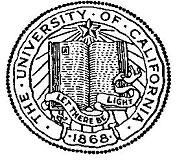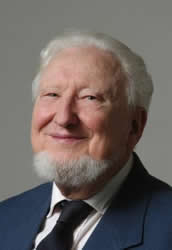

|

|
IN MEMORIAM
Otto J. M. Smith
Professor of Electrical Engineering and Computer Sciences, Emeritus
UC Berkeley
1917 – 2009
Otto J. M. Smith, professor emeritus in the Department of Electrical Engineering and Computer Sciences (EECS) at the University of California, Berkeley, died on May 10, 2009, from injuries sustained in an accidental fall. He was 91 at the time of his death. An active researcher and inventor working in the field of energy production and efficiency, he was deeply concerned about global warming and devoted much of his later life to developing technologies and working for policies that would mitigate man-made disasters.
Otto J. M. Smith was born on August 6, 1917, in Urbana, Illinois. In 1923, he moved with his family to Stillwater, Oklahoma, where his father was head of the Department of Chemistry and Chemical Engineering at Oklahoma Agricultural and Mechanical College (Oklahoma A & M). He obtained concurrent B.S. degrees in electrical engineering, from the University of Oklahoma, Norman, and in chemistry from Oklahoma State University, Stillwater, in 1938. He received a doctorate in electrical engineering from Stanford University in 1941. It was there that he met his future wife and lifelong companion, Phyllis Sterling. At his death they had been married for 67 years. He was a member of the EECS faculty at UC Berkeley since 1947 and emeritus since 1988.
Otto had a continual thirst for knowledge and an ability to turn theory into practical working projects. He is probably best known for his development of the “Smith predictor”, a method of analyzing feedback control systems with process delays. This work has found widespread application in the chemical process industry, and the theory and applications have been extended by others.
An early patent was granted in 1956 for a sine-function signal generator. It was sold to Hewlett Packard and was in general use long after the expiration of the patent. Since 1976 all of his patents have been awarded for devices to generate or conserve energy, including designs relating to solar electric power plants, wind generators, and high efficiency motors. Professor Smith was granted at least 30 U.S. patents as well as foreign patents. At the time of his death he was pursuing two more patents which had been applied for but not yet finally approved. His most recent work has been in the development of new and innovative methods and devices (e.g. the “phaseable enabler”) for making it possible to run three-phase induction motors on single-phase power lines. Indicated applications are for use at farms and mines in remote areas that are only served by single-phase electric power.
Otto Smith received many honors throughout his career, including a Guggenheim Fellowship in 1960, R&D Magazine’s 1999 award for “One of the 100 Most Technologically Significant and New Products” (for the phaseable enabler), and in 2003 was listed in InTech, the International Society of Automation’s house publication, as one of the “50 Most Influential Industry Innovators Since 1774.” He was a fellow of the Institute of Electrical and Electronic Engineers, the world’s preeminent professional society for electrical engineers, and a fellow of the American Association for the Advancement of Science.
Otto enjoyed working with colleagues, students, staff and alumni. He was friendly and generous, lively and energetic. He loved to meet and talk to people and in conversation was totally engaged with them. Even people he had only met casually remembered him well after many years. While an enthusiastic proponent of his own ideas and causes, Otto was always interested in hearing the viewpoints of others.
Professor Smith taught a wide variety of EECS courses in the systems and power areas. He took his teaching responsibilities seriously and was known as a stimulating and effective teacher. He was deeply concerned about undergraduate and graduate students both in and out of the classroom and was very popular with them. He wrote over 150 papers and a well-received textbook on feedback control published by McGraw Hill in 1958.
Otto’s colleagues remember his energetic lecturing style. In a lecture about “posicast control,” to be more visible to his audience, Otto would jump from the floor onto a desk in one continuous motion. Out of his pocket would come a string with attached plumb bob. He explained that he was going to move the bob sideways without any oscillations. Using posicast theory he would move the plumb bob hanging from his hand to a desired final position in two stages. In the first stage he would move his hand part way toward the desired final bob location and then as the bob (swinging past his hand) reached the extreme of its swing (the desired final position) he quickly moved his hand right above the bob, which then came to rest. The motion of the bob was fast, monotonic, without any oscillatory behavior or overshoot. This certainly made a powerful and unforgettable impression on the audience! This tabletop demonstration was an indoor version of the practical problem of moving a load suspended by a cable to a gantry crane. Using posicast principles (by calculations or experience) the crane operator can also move a load quickly and without overshoot.
Otto Smith’s deeply held conviction that he should help to make the world a better place was not limited to his technical work. He traveled widely and gave numerous presentations to groups of all ages on diverse topics such as “Bats in the Belfry” and “Engineering Ethics.” In a lecture to Boy Scouts, an orange at one side of a field and the head of a pin at the other side demonstrated the relative size and the distance between the sun and earth. Slides of paddy fields enlivened talks on Asia. He took his family along on many of his trips, introducing his children and grandchildren to geography, diversity, and international relations. He was a pacifist, a World Federalist, a believer in the rule of law, an atheist, a humanist, and active in political causes. He participated with his students in strikes and protests against the Viet Nam war and actively supported his wife in her extensive volunteer work with the Berkeley Free Church, the Ecumenical Chaplaincy to the Homeless, and other social causes.
He is survived by his wife Phyllis Sterling Smith, their four children and their spouses, twelve grandchildren, and six great-grandchildren.
Arthur Bergen 2010
Allan Lichtenberg
Michael Lieberman